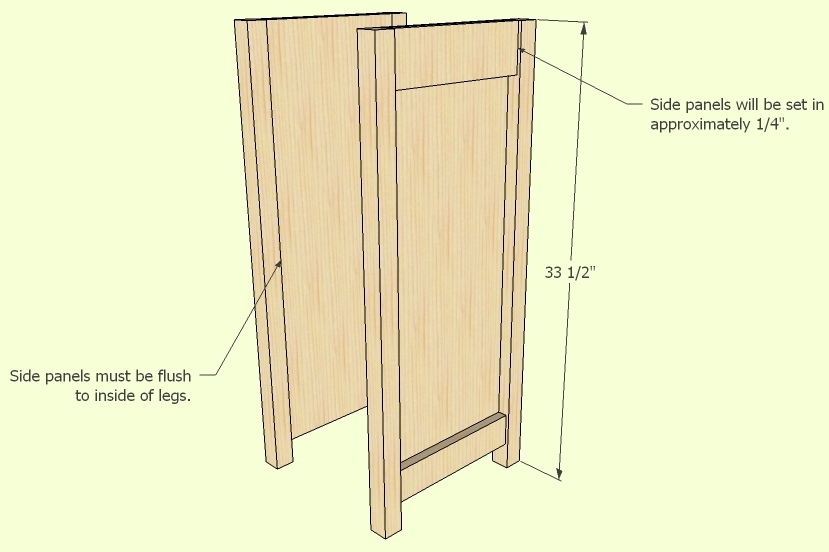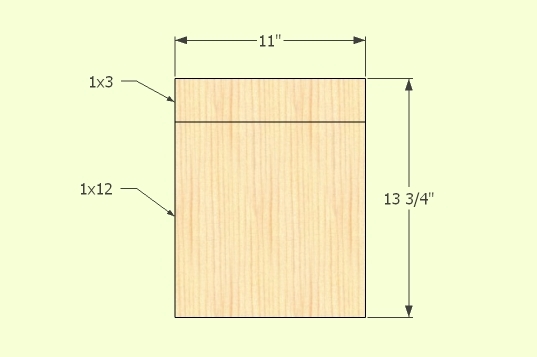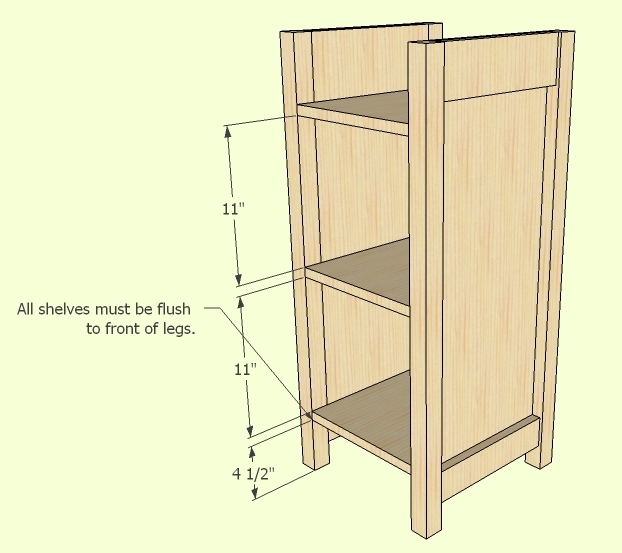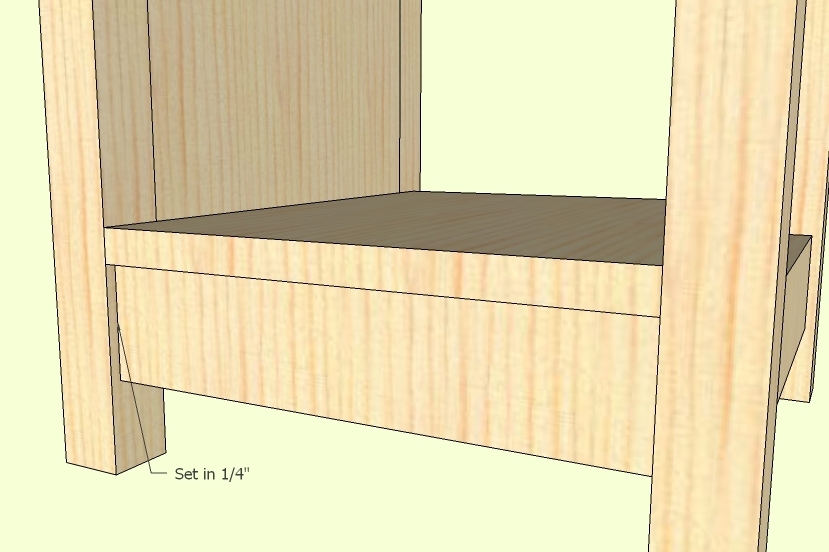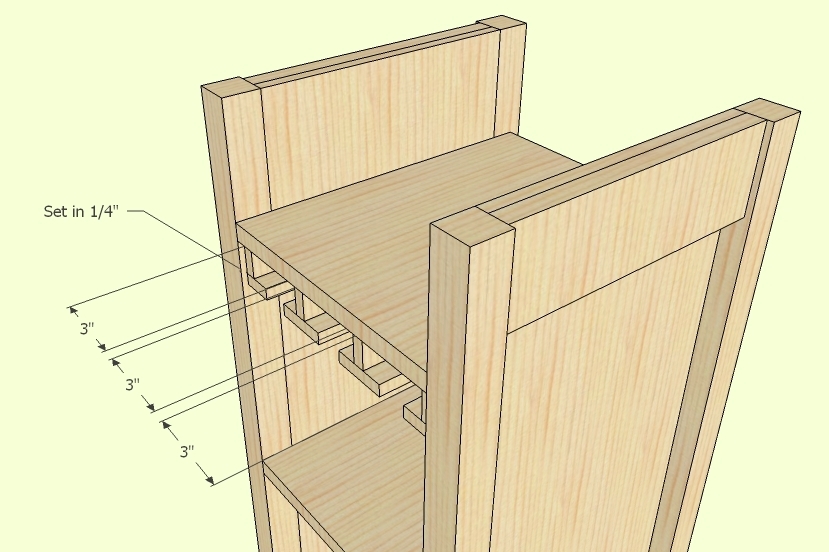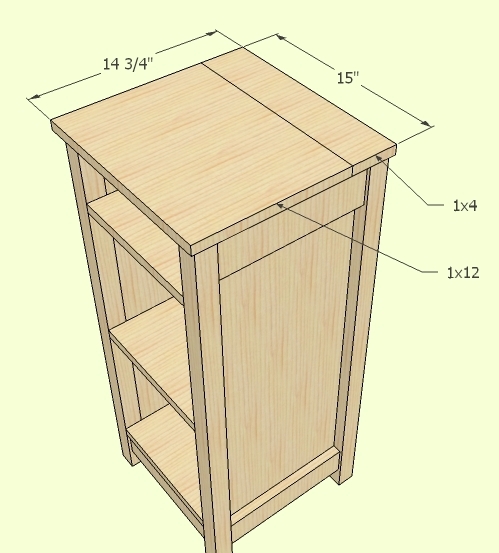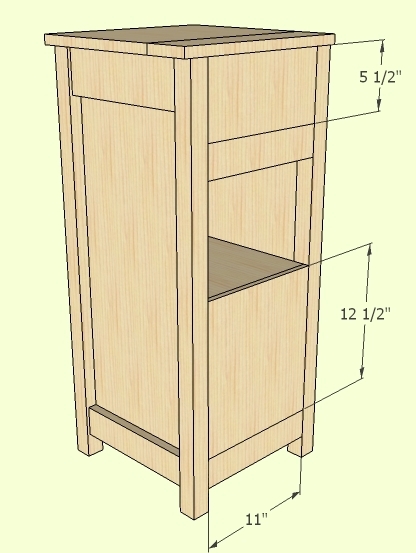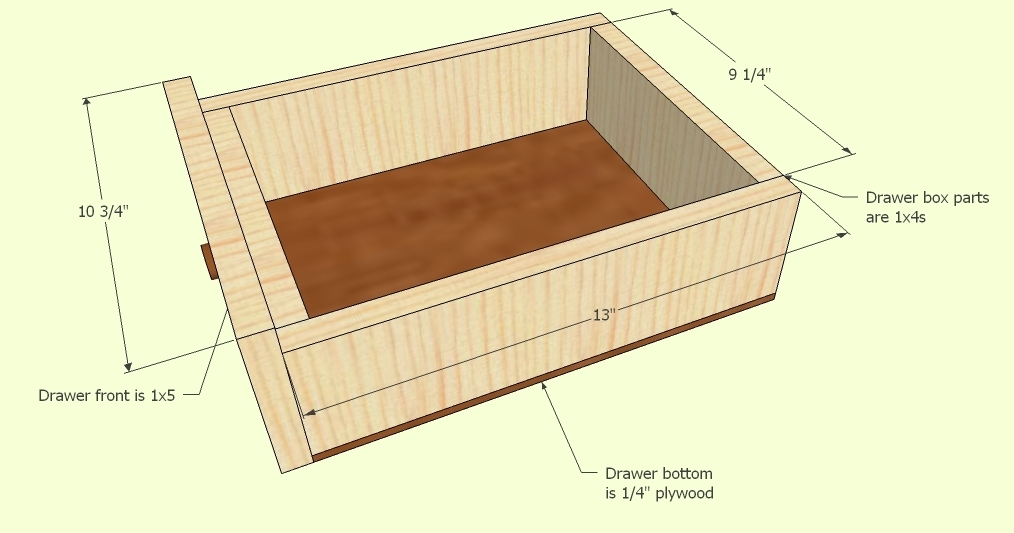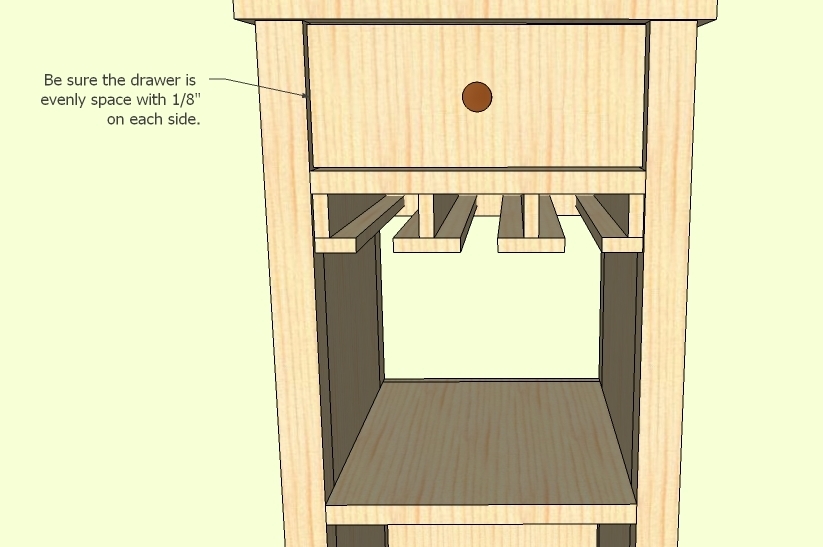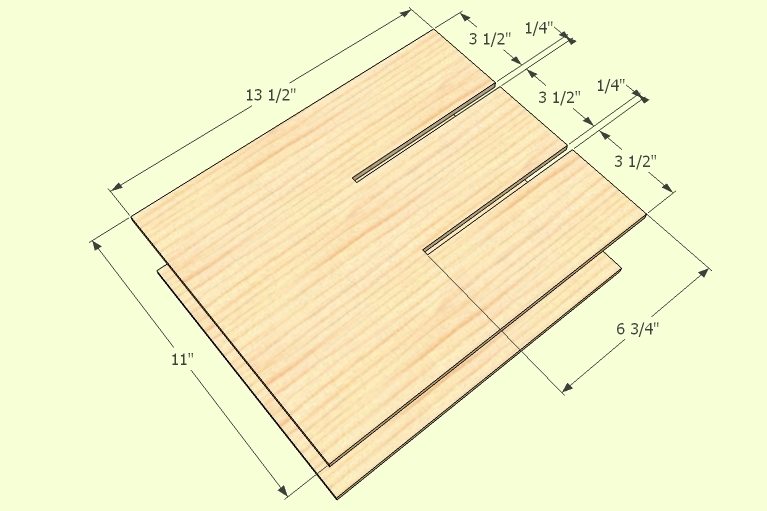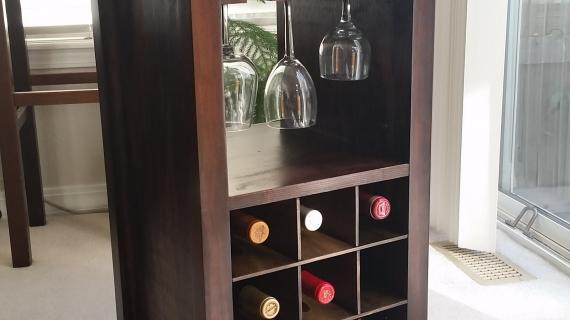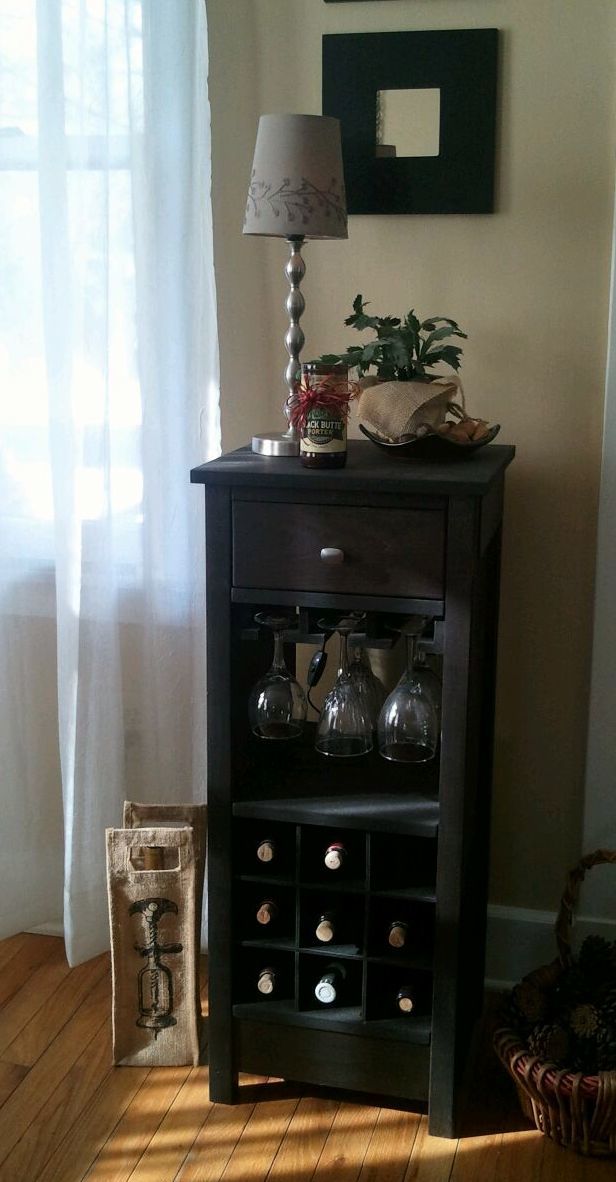
I loved Lady Goats Mod Wine Bar, but it was too large for my dining room. I was also inspired by a plan on woodcraft.com that incorporated the stemware in the cabinet. I combined the best elements of each plan and came up with my "Mini Mod Wine Bar". I've built many plans from this site, so I thought it was time to contribute. After I built my original cabinet, I made some tweaks to the plan and the result is the plan below. This is my first published plan, so bear with me :) Please let me know if there are any errors, revisions needed or if you have any questions. Enjoy and good luck!
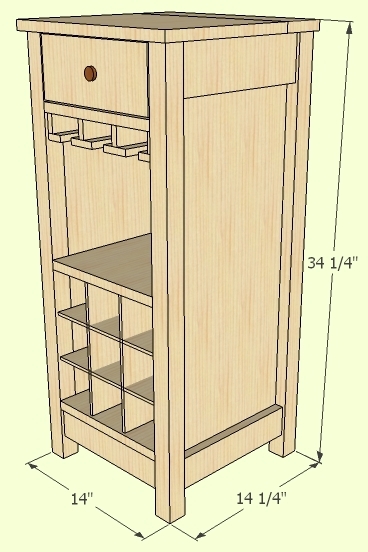
Preparation
1 sheet 4'x8' 1/2" plywood (you'll have extra)
2 2x2x8
9 feet of 1x4 boards
8 feet of 1x3 boards
5 feet of 1x12 boards
1 foot of 1x5 boards
1 1/4" wood screws
1 1/4" finish nails
1" pocket screws
1 1/4" pocket screws
knob
wood glue
120 grit sandpaper
2 - 1/2" plywood 11 1/4" x 31 1/2"
2 - 1x4 @ 11 1/4"
2 - 1x3 @ 11 1/4"
4 - 2x2 @ 33 1/2"
3 - 1x12 @ 11"
8 - 1x3 @ 11"
2 - 1/2" plywood 2 1/4" x 13 1/2"
2 - 1/2" plywood 1 3/8" x 13 1/2"
2 - 1/2" plywood 1 1/2" x 13 1/2"
1 - 1x4 @ 15"
1 - 1x12 @ 15"
1 - 1/2" plywood 11" x 5 1/2"
1 - 1/2" plywood 11" x 12 1/2"
2 - 1x4 @ 13"
2 - 1x4 @ 9 1/4"
1 - 1x5 @ 10 3/4"
1 - 1/4" plywood 10 3/4" x 13"
4 - 1/4" plywood 11" x 13 1/2"
The side panels are made from 1/2" plywood. To make them, rip the 1/2" plywood to width (11 1/4"), then cut to length. The shelves, front rail, back rails, top supports, back pieces and bottle dividers are all the same width (11"), set your saw once and cut all these pieces to width at the same time to ensure a perfect fit.
Please read through the entire plan and all comments before beginning this project. It is also advisable to review the Getting Started Section. Take all necessary precautions to build safely and smartly. Work on a clean level surface, free of imperfections or debris. Always use straight boards. Check for square after each step. Always predrill holes before attaching with screws. Use glue with finish nails for a stronger hold. Wipe excess glue off bare wood for stained projects, as dried glue will not take stain. Be safe, have fun, and ask for help if you need it. Good luck!
Instructions
Step 1
Build two side panels. First cut 1x2s and 1x4s to the width of the plywood side panel (11 1/4"), then attach with glue and 1 1/4" finish nails (nail from the inside to avoid nail holes on the outside of the piece).
You'll also need to make pocket holes in the front and back edge of each side panel to attach the legs in step 2. Make pocket holes for 1/2" stock and position the holes so the will be hidden by other elements of the piece (see diagram). This way you'll avoid having to fill any pocket holes.
Step 2
Step 3
Step 4
Attach completed shelves using pocket holes set for 1/2" stock and 1" pocket hole screws. Start with the bottom shelf and work up. For alignment purposes it's helpful to cut two pieces of scrap wood 4 1/2" tall. Clamp the scrap to the bottom of each side panel, then you can set the shelf on top of the scrap and attach the shelf with pocket screws. For the next shelf, cut two pieces of scrap wood 11" tall. Set the scrap on top of the first shelf and clamp to the side panel, then set the shelf on top of the scrap and attach the shelf with pocket screws. Repeat for the final shelf. NOTE: Be sure all shelves are flush to the front legs (the back of the shelf will be set in approximately 1/2" from the back of the legs to accept the back panels in Step 8)
Step 7
Step 8
Step 9
Step 10
Step 12
I hate drawer slides, so this plan doesn't use any! Measure the drawer opening before cutting any drawer parts. Please allow for 1/8 " on the right and left side of the drawer, so it will move freely. Adjust the dimensions of the drawer if necessary. Cut the drawer box part and assemble using pocket holes set for 3/4" stock and 1 1/4" pocket hole screws.
Step 13
Cut the drawer front (be sure to allow 1/8" on each side of the drawer front). Slide the drawer box into the opening and shim the drawer front so it's evenly spaced in the opening (coins make great shims!). Drill a hole for the knob, remove drawer front, drawer box and install the knob. Reinstall the drawer and adjust spacing around drawer front then tighten the knob screw. From inside the box use two 1 1/4" wood screws to secure the drawer front to the drawer box. Cut 1/8" hardboard and install to the bottom of the drawer with 1 1/4" finish nails.
Step 14
The four pieces that make up the bottle dividers are 1/4" plywood and are identical. The easiest way to make them is with a router table and a 1/4" straight cutting bit. Set the fence for 3 1/2" and make a pass to the 6 3/4" mark, then flip and make a second pass - that's it! Once cuts are made on all four pieces, assemble (it will be a snug fit, so glue isn't needed) and install in the bottle divider area.
It is always recommended to apply a test coat on a hidden area or scrap piece to ensure color evenness and adhesion. Use primer or wood conditioner as needed.
















